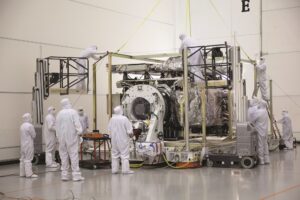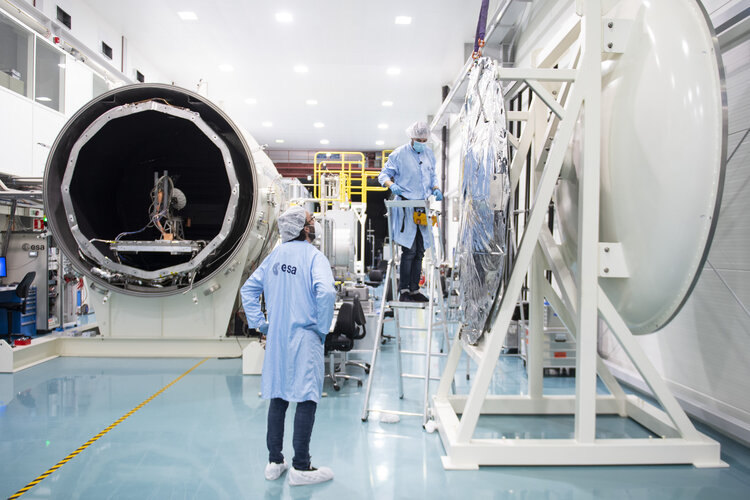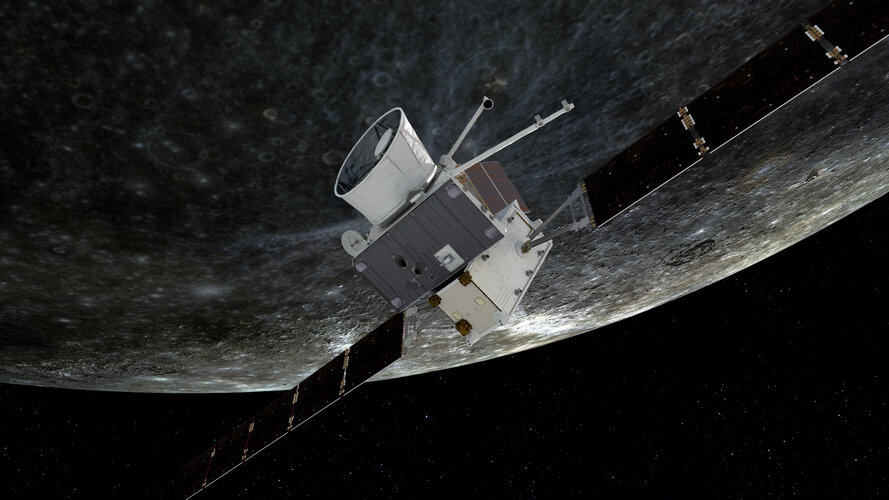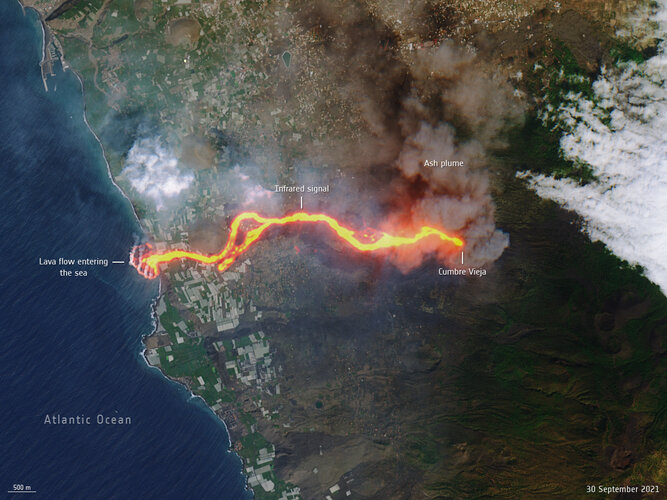Ball Aerospace and L3Harris win NOAA instrument study contracts
Friday, 01 October 2021 14:07
The National Oceanic and Atmospheric Administration awarded contracts to Ball Aerospace & Technologies and L3Harris Technologies to study instruments for Geostationary and Extended Observations (GeoXO), the agency’s next generation of geostationary satellites.
Ball Aerospace and L3Harris win weather instrument study contracts
Friday, 01 October 2021 14:07
The National Oceanic and Atmospheric Administration awarded contracts to Ball Aerospace & Technologies and L3Harris Technologies to study instruments for Geostationary and Extended Observations (GeoXO), the agency’s next generation of geostationary satellites.
Lorentz test chamber at Sunday's Open Day
Friday, 01 October 2021 13:18 Image:
Lorentz test chamber at Sunday's Open Day
Image:
Lorentz test chamber at Sunday's Open Day Week in images: 27 September - 1 October 2021
Friday, 01 October 2021 12:00
Week in images: 27 September - 1 October 2021
Discover our week through the lens
Navigating a very close approach
Friday, 01 October 2021 11:52
Tonight, BepiColombo will perform the first of six Mercury flybys, each honing the spacecrafts’ trajectory with the ultimate goal of shedding enough energy – after its two years ‘falling’ towards the Sun – to be caught by the innermost planet’s gravity and remain in Mercurial orbit.
La Palma lava flows into the sea
Friday, 01 October 2021 11:40 Image:
This image, captured by Copernicus Sentinel-2 on 30 September, shows the flow of lava from the volcano erupting on the Spanish island of La Palma.
Image:
This image, captured by Copernicus Sentinel-2 on 30 September, shows the flow of lava from the volcano erupting on the Spanish island of La Palma. Blue Origin accused of 'toxic' work culture, compromising safety
Friday, 01 October 2021 10:51 A group of current and former Blue Origin employees on Thursday accused Jeff Bezos' space company of having a "toxic" work culture with rampant sexual harassment and a pattern of decision-making that prioritized speedy rocket development over safety.
The allegations, firmly rejected by Blue Origin, were outlined in a lengthy blogpost signed by Alexandra Abrams, the company's former head of e
A group of current and former Blue Origin employees on Thursday accused Jeff Bezos' space company of having a "toxic" work culture with rampant sexual harassment and a pattern of decision-making that prioritized speedy rocket development over safety.
The allegations, firmly rejected by Blue Origin, were outlined in a lengthy blogpost signed by Alexandra Abrams, the company's former head of e NASA selects crew for simulated trip to a Mars Moon
Friday, 01 October 2021 10:51 Have you ever wondered what it would be like to head deep into space, all the way to Mars? Through a simulated journey, four volunteer research subjects will soon have a chance to find out.
Beginning Oct. 1, 2021, four people will live and work for 45 days inside a unique, ground-based habitat at NASA's Johnson Space Center in Houston. Designed to serve as an analog for isolation, confinem
Have you ever wondered what it would be like to head deep into space, all the way to Mars? Through a simulated journey, four volunteer research subjects will soon have a chance to find out.
Beginning Oct. 1, 2021, four people will live and work for 45 days inside a unique, ground-based habitat at NASA's Johnson Space Center in Houston. Designed to serve as an analog for isolation, confinem Building a home in the sky
Friday, 01 October 2021 10:51 After initial solid steps, upcoming missions will ensure operation of China's Tiangong space station. China plans to conduct its Shenzhou XIII manned space flight this month, sending three astronauts to stay six months inside the country's Tiangong space station.
During their mission, the astronauts, whose names have yet to be disclosed, will be mainly tasked with demonstrating and testing
After initial solid steps, upcoming missions will ensure operation of China's Tiangong space station. China plans to conduct its Shenzhou XIII manned space flight this month, sending three astronauts to stay six months inside the country's Tiangong space station.
During their mission, the astronauts, whose names have yet to be disclosed, will be mainly tasked with demonstrating and testing Heavy bombardment experienced by the planets in the early Solar System
Friday, 01 October 2021 10:51 At approximately 500 kilometres in size, Vesta is the largest known asteroid in the Solar System. Like its numerous companions in the Main Asteroid Belt, it is made of the 'primordial matter' of the Solar System. A new study published in Nature Astronomy concludes that Vesta was exposed to an extensive impact series of large rocky bodies much earlier than previously assumed. This suggests that t
At approximately 500 kilometres in size, Vesta is the largest known asteroid in the Solar System. Like its numerous companions in the Main Asteroid Belt, it is made of the 'primordial matter' of the Solar System. A new study published in Nature Astronomy concludes that Vesta was exposed to an extensive impact series of large rocky bodies much earlier than previously assumed. This suggests that t Galileo ground control segment ready for full operational capability
Friday, 01 October 2021 10:51 In early July the European Union Agency for the Space Programme (EUSPA) announced the upcoming upgrades of the Galileo GCS infrastructure in preparation for the next launch .
Today the new GCS V3.0 infrastructure has been completely deployed in the Galileo Ground Control Centres in Oberpfaffenhofen (Germany) and Fucino (Italy) and is being used to operate the Galileo Satellite Constellatio
In early July the European Union Agency for the Space Programme (EUSPA) announced the upcoming upgrades of the Galileo GCS infrastructure in preparation for the next launch .
Today the new GCS V3.0 infrastructure has been completely deployed in the Galileo Ground Control Centres in Oberpfaffenhofen (Germany) and Fucino (Italy) and is being used to operate the Galileo Satellite Constellatio Phantom Space announces agreement to build and launch 72 satellite constellation for Ingenu
Friday, 01 October 2021 10:51 Phantom Space Corporation, a space transportation technology development and manufacturing company, has announced that they signed an agreement with Ingenu, provider of one of the leading Industrial Internet of Things (IIoT) technology platforms.
The agreement includes the production, manufacturing and launch of a 72 satellite constellation (AFNIO) that Ingenu will be utilizing to host the
Phantom Space Corporation, a space transportation technology development and manufacturing company, has announced that they signed an agreement with Ingenu, provider of one of the leading Industrial Internet of Things (IIoT) technology platforms.
The agreement includes the production, manufacturing and launch of a 72 satellite constellation (AFNIO) that Ingenu will be utilizing to host the RockSat-X team witnesses experiment launched into space
Friday, 01 October 2021 10:51 On the Eastern Shore of Virginia against a clear blue August sky, a sounding rocket stood ready on the launchpad at the NASA Wallops Flight Facility. With undergraduate student teams, faculty advisors, and family eagerly awaiting and viewing the launch via livestream coverage, the countdown began.
Late in the afternoon of Aug. 19, the Terrier-Improved Malemute sounding rocket successfully
On the Eastern Shore of Virginia against a clear blue August sky, a sounding rocket stood ready on the launchpad at the NASA Wallops Flight Facility. With undergraduate student teams, faculty advisors, and family eagerly awaiting and viewing the launch via livestream coverage, the countdown began.
Late in the afternoon of Aug. 19, the Terrier-Improved Malemute sounding rocket successfully FAA clears Virgin Galactic to resume flights after investigation
Friday, 01 October 2021 10:51 The Federal Aviation Administration said Wednesday that Richard Branson's space tourism company can return to spaceflight after conducting an investigation into issues with the firm's July 11 launch.
A probe into the flight, which included Branson as a passenger, found the company's SpaceShipTwo deviated from its assigned airspace as it descended to Spaceport America in New Mexico, accordi
The Federal Aviation Administration said Wednesday that Richard Branson's space tourism company can return to spaceflight after conducting an investigation into issues with the firm's July 11 launch.
A probe into the flight, which included Branson as a passenger, found the company's SpaceShipTwo deviated from its assigned airspace as it descended to Spaceport America in New Mexico, accordi Lake breach flooding played big role in Martian geography
Friday, 01 October 2021 10:51 A significant amount - at least 25 percent - of Martian valley networks formed as a result of lake breach flooding, as reported in a paper on which Planetary Science Institute Research Scientist Alexander Morgan is an author.
This helps us better understand the past climate history of Mars, said Morgan, a co-author on "The importance of lake breach floods for valley incision on early Mars"
A significant amount - at least 25 percent - of Martian valley networks formed as a result of lake breach flooding, as reported in a paper on which Planetary Science Institute Research Scientist Alexander Morgan is an author.
This helps us better understand the past climate history of Mars, said Morgan, a co-author on "The importance of lake breach floods for valley incision on early Mars" 